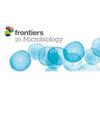Impact of weight variation on the microbiome of yak dams and calves
IF 4
2区 生物学
Q2 MICROBIOLOGY
引用次数: 0
Abstract
IntroductionLimited information exists regarding the microbiome composition of yak calves of varying weights. Therefore, this study aimed to investigate the microbiomes of mother-calf pairs with different weight profiles.MethodsFecal and blood samples were collected from both lower-weight (CB) and higher-weight (HB) yak calves, along with their corresponding female yaks (CA, HA).ResultsThe results revealed significantly higher levels of T-AOC (total antioxidant capacity) and GSH-Px (glutathione peroxidase) in HB animals (体重变化对牦牛母牛和小牛微生物群的影响
引言 有关不同体重的牦牛犊微生物组组成的信息有限。方法收集体重较轻(CB)和体重较重(HB)的牦牛犊及其相应母牦牛(CA、HA)的粪便和血液样本。结果结果显示,HB动物的T-AOC(总抗氧化能力)和GSH-Px(谷胱甘肽过氧化物酶)水平显著较高(p&;lt;0.001)。母牦牛和小牦牛的测序结果分别为 652,181 和 643,369 个过滤读数。α多样性分析表明,与HA相比,CA中的Chao1、Faith_pd和Observed物种明显较多(p&;lt; 0.01)。此外,HA牦牛和CA牦牛有9个属存在明显差异,包括Avispirillum、Fimenecus、CAG-1031、Odoribacter 865974和Jeotgalicoccus A 310962。与 CB 型牦牛相比,CA 型牦牛在 1 个门和 6 个属中表现出显著差异,包括 CAG-485 (p < 0.05)、CAG-83 (p < 0.01)、Copromorpha (p < 0.01)、Phocaeicola A 858004 (p < 0. 05) 和 UBA2253。结论总之,体重较高的牦牛犊表现出更强的抗氧化能力,体重特征与母牦牛及其犊牛的微生物组有关。这些发现为优化高海拔地区的牦牛饲养方法提供了宝贵的见解。
本文章由计算机程序翻译,如有差异,请以英文原文为准。
求助全文
约1分钟内获得全文
求助全文
来源期刊

Frontiers in Microbiology
MICROBIOLOGY-
CiteScore
7.70
自引率
9.60%
发文量
4837
审稿时长
14 weeks
期刊介绍:
Frontiers in Microbiology is a leading journal in its field, publishing rigorously peer-reviewed research across the entire spectrum of microbiology. Field Chief Editor Martin G. Klotz at Washington State University is supported by an outstanding Editorial Board of international researchers. This multidisciplinary open-access journal is at the forefront of disseminating and communicating scientific knowledge and impactful discoveries to researchers, academics, clinicians and the public worldwide.
 求助内容:
求助内容: 应助结果提醒方式:
应助结果提醒方式:


